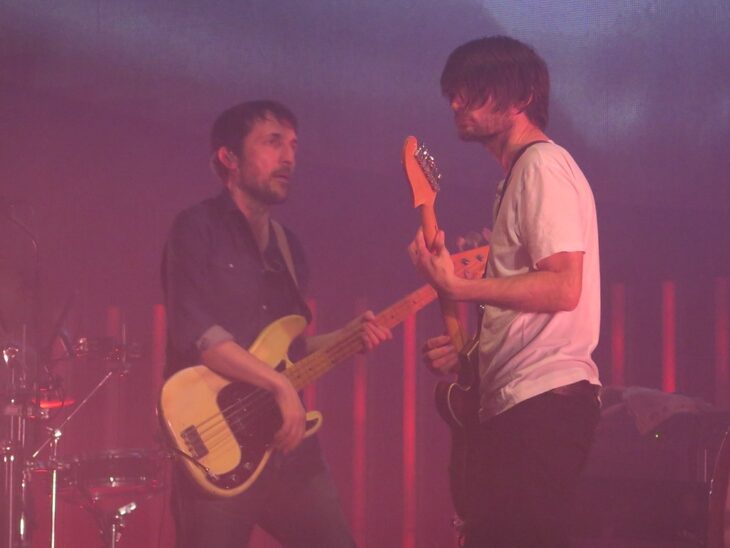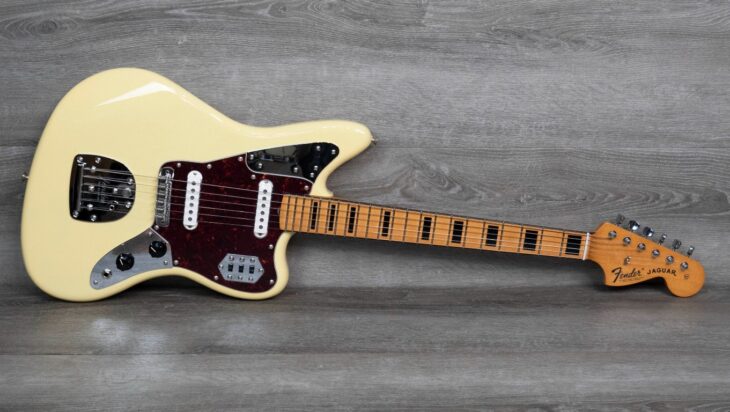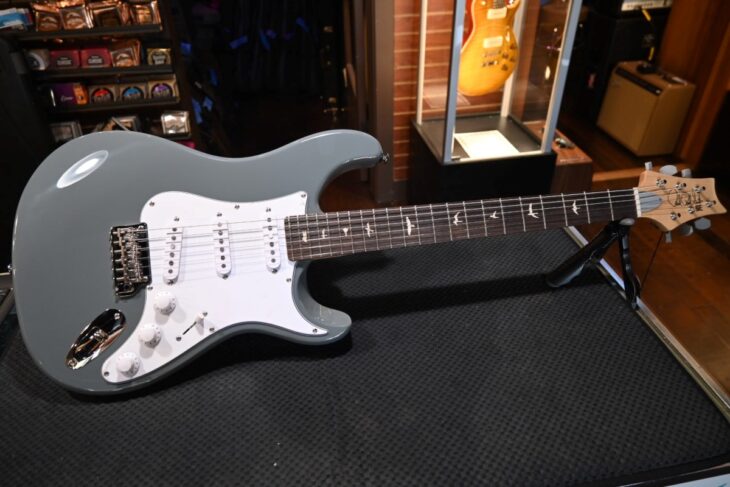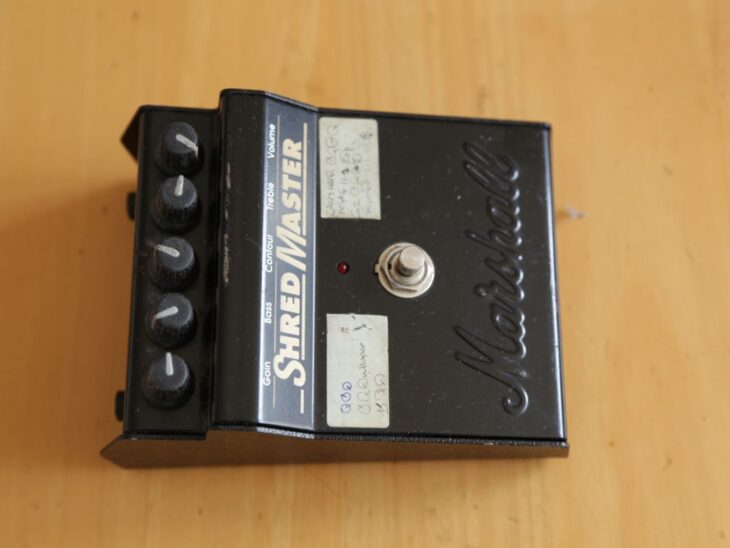Radiohead, despite constantly reinventing their sound, image, and even methods of musical delivery, remain one of the foremost rock bands of the 21st century.
The band may have started as a one-more-90s Britpop/alternative fusion, but in embracing new technology, new sounds, and new ways of delivering music (including streaming in 2000, long before anyone had heard the word “Spotify), they became true giants of the music industry.
Radiohead’s sprawling catalog covers countless genres, textures, and tones. It would be almost impossible to list all the gear the band has used over the years to get their sounds.
However, if you’re anything like me, your first exposure to Radiohead was their massive hit single “Creep.”
With punishing, crunching distorted tones and ethereal clean arpeggios, “Creep” offers a 90s tone holy grail for guitar players. In this article, I’ll run through the key pieces of gear necessary to access the key guitar sounds on Radiohead’s biggest hits, including “Creep,” “Karma Police” and “Street Spirit.”
Table of Contents
Radiohead Guitars

Radiohead’s guitar duo, since the very beginning, was Jonny Greenwood and Ed O’Brien. Greenwood’s contribution to the band is not limited to playing guitar: he’s provided orchestral arrangements and electronic instrumentation to the band for decades now.
O’Brien’s primary contribution to Radiohead’s sound is song-serving textures and atmospheric effects.
Greenwood is best known for wielding Fender guitars, most notably the Telecaster Plus, although he has switched to a Starcaster upon occasion, typically for softer, less aggressive tracks.
Ed O’Brien, too, prefers Fender guitars, although his taste extends primarily to Stratocasters, with occasional dabbling in Gretsch or Rickenbacker instruments.
The clean, arpeggiated Radiohead sound has always, to me, been a classic Fender single-coil clean tone. Jonny Greenwood’s Tele sound is distinct in that he uses Lace Sensor pickups, which are subtly different from typical single-coil pickups. These have a coil surrounded by metal barriers to reduce hum and noise.
This sound is closer, in practice, to that of the Fender Jaguar. They have less chime, twang, and harmonic overtones than that of a typical Telecaster single-coil pickup. Lace Sensor pickups aren’t easy to come by these days, and date a guitar’s tone somewhat to the 90s.

I’d recommend a close modern equivalent, the Fender Noiseless pickup, and put these in a Telecaster. Either the Player Plus or Squier Classic Vibe 50s Telecasters are great options for this sound.
Ed O’Brien’s Strat tone is, to my ear, a pretty standard Stratocaster sound, so you could feasibly emulate most of it with any good-quality Strat, like the Player Strat or the Squier Classic Vibe.
A more versatile option, to open some tonal possibilities for other Radiohead textures, might be PRS’ Strat clone (or a Super Strat, if you’d like), the Silver Sky.

Alternatively, you could lean heavily into the Radiohead gear zone and simply play Ed O’Brien’s signature Stratocaster.
Radiohead Amps
Radiohead, in the studio, almost exclusively used high-headroom Fender amplification. Specifically, for “Creep,” and most of their other ‘90s hits, the twin axemen used a Fender Deluxe 85 and a Fender Twin Reverb.
In my opinion, these amps are a huge part of the Radiohead sound. First and foremost, this is because of their high-fidelity clean tone. Secondly, their capacity to handle pedals is unparalleled: they’re the original “pedal platform” amplifiers.
The Tonemaster is an excellent Fender amp, albeit a solid-state one that lacks the chime and warmth of a tube amplifier. You could use the Hot Rod Deluxe, a tube amp, but I’d recommend against using either of its dirt channels for your base Radiohead sound. Most of Radiohead’s distortion came from their use of cheap, nasty distortion pedals.

Greenwood has also been a loyal player of the classic British amplifier: the Vox AC30. I’d recommend the smaller, more portable AC15. The Vox amps are harder to tame at low volume than Fender amps, but they have similar clean tones.
Radiohead Amp Settings
These are the amp settings I use for the basic Radiohead clean tone. Most of their tone comes from pedals and note choice, so we’re trying to run a neutral, nice-sounding foundation for the Radiohead sound.
Volume: 6
Not too much, not too little. Just enough to get the tubes warming up if you’re on a tube amp. For a solid state amp, just set the volume to a comfortable level.
Bass: 4
You only need a little warmth for this sound,
Mids: 7
A slight spike in the midrange helps get your arpeggios sounding nice and lively.
Treble: 3.5-4
You don’t need much treble on these amps and guitars.
Gain: 5
You don’t want enough gain to give your tone any saturation: you just need enough to bring it to life.
Radiohead Pedals
The key distortion pedal for the early Radiohead tone is the Marshall Shredmaster.

While this seems like a left-field choice for Radiohead, its aggressive, chunky tone is responsible for the colossal distortion you can hear on “Creep.” You’ll need to run the Shredmaster pretty much flat out, Hendrix style: turn all the knobs all the way up.
To tame the tremendous amount of noise and hiss that comes with the Shredmaster at full bore, you’ll want to use a noise suppressor. The Boss Noise Suppressor is arguably the most popular noise gate in the business and was used heavily by alternative bands in the 90s.
For their clean tones, Radiohead uses a lot of subtle effects to give their tones color and shape. Typically, you can hear them using chorus, delay, and compression. Ed O’Brien, these days, prefers to paint a canvas of textures and atmospheres to support Thom Yorke’s vocals.
He often uses the Electro-Harmonix Memory Man as his main delay pedal and has done so since the 1990s.

However, around OK Computer and The Bends O’Brien used a Boss Digital Delay extensively.
Either of these delay pedals would do the trick, but the EHX Memory Man, to my ear, gets closer to the alt-rock Radiohead sound, while the Digital Delay sounds more like Radiohead’s more experimental electronic-influenced music.
Jonny Greenwood also uses the Digitech Whammy for his extreme, glitchy pitch-shifted effects and sounds. Greenwood’s preferred reverb is the EHX Holy Grail, and his preferred modulation effect is the EHX Small Stone phase shifter.
Greenwood used the EHX Poly Chorus, which is no longer in production. However, the Small Clone, a chorus pedal made by the same brand, is the closest modern equivalent to that pedal.
Ed O’Brien’s signature Strat comes with a built-in sustainer pickup, but for an ordinary Stratocaster you’ll need a sustainer pedal. I like the Boss Compressor Sustainer because it offers compression as well as sustain. If you want a separate compression unit – perhaps to offer differing compression levels for different tones – I recommend the Keeley Compressor Plus.

Final Word
Capturing Radiohead’s array of guitar tones is a mammoth task, but given that Greenwood and O’Brien learned to play guitar while in Radiohead, it’s certainly not impossible.
The key ingredients, particularly for the simpler sounds of “Creep,” are a Fender guitar, a Fender amp, and a Marshall Shredmaster. Adding some compression and echo will help liven up your arpeggios, and get you closer to the coveted alternative tones Radiohead made famous in the 1990s.

